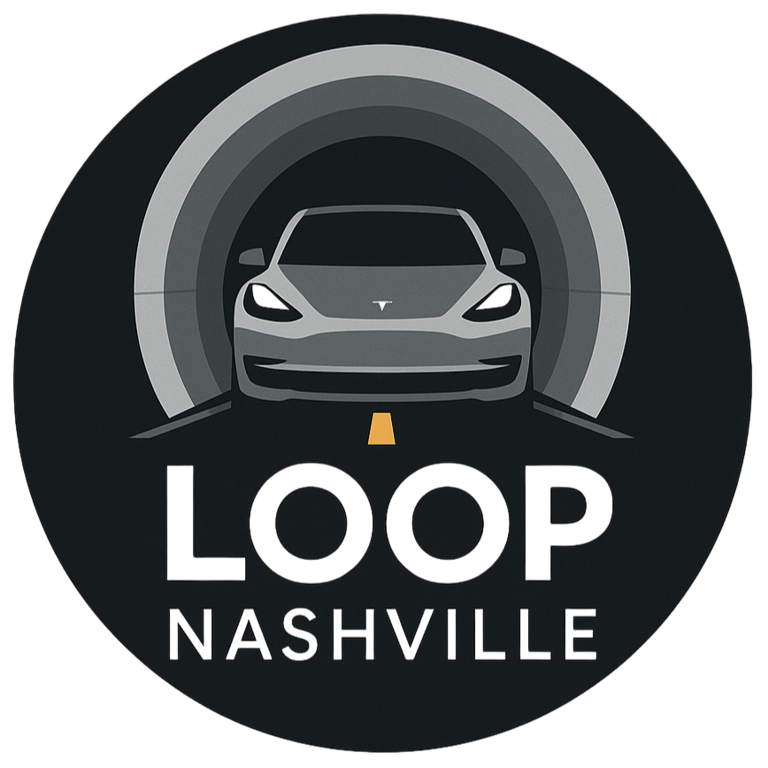Could the Music City Loop One Day Reach Opryland?
A future Loop branch down Briley Parkway could connect Opryland to downtown, open new development corridors, and give the iconic resort a high-speed link to Music City’s core. [Read more ➝]
By the LOOP Nashville Editorial Staff
9/6/20253 min read
By the LOOP Nashville Editorial Staff
The Music City Loop, a 10-mile underground transportation system being developed by The Boring Company, is moving from concept to construction. The first phase, announced earlier this summer, will link Nashville International Airport to downtown, with planned stops at the Convention Center and the State Capitol. Travel times between the airport and downtown are expected to be cut to under ten minutes, using Tesla vehicles running through twin tunnels beneath state-owned roads.
Construction is slated to begin later this year, with the first phase projected to open as soon as late 2026. The project has gained momentum in part because it relies on state-owned rights of way, allowing The Boring Company to bypass many of the local obstacles that have slowed other large infrastructure efforts. That same framework is now sparking speculation about how future expansions could extend beyond the downtown-to-airport corridor.
A Potential Spur to Opryland
Among the most compelling possibilities is a branch of the Loop running to Opryland. Home to the Gaylord Opryland Resort and Convention Center, the Grand Ole Opry, and Opry Mills, the area remains one of Nashville’s most visited destinations — yet it is notoriously disconnected from the city’s core.
A Loop connection could change that dynamic. To stay within state jurisdiction, the line would likely follow Briley Parkway, tying into Ellington Parkway before rejoining the downtown core. That alignment would allow the Opryland branch to link directly to the Loop’s first phase without crossing Metro-owned land, creating a legally and logistically viable expansion path.
Unlocking Briley Parkway’s Potential
Such a route would do more than connect a hotel. The Briley Parkway corridor is dotted with aging strip malls, vacant parcels, and large stretches of underutilized land. A Loop branch could transform it into one of Nashville’s most attractive redevelopment corridors, opening the door for new housing, retail, and mixed-use projects.
Supporters say it could mirror the way other cities have leveraged transit investment to jump-start entire districts. “If you look at what’s happened in places like Arlington, Virginia, or Denver’s Union Station district, the transit was the catalyst,” one Nashville planner said. “Briley Parkway could be our version of that if the Loop runs through it.”
The corridor would also gain new importance as a connector to the east bank, where the city is pursuing an ambitious redevelopment anchored by the new Titans’ training studios. A high-speed underground route could knit Opryland, the east bank, and downtown into a single economic zone, expanding the reach of Nashville’s growth beyond the central business district.
What Opryland Stands to Gain
For Opryland itself, the benefits could be immediate and substantial. The Gaylord Opryland Resort currently funds shuttle buses to ferry guests downtown — a costly service that is slower and less reliable than most visitors expect. Reinvesting that money into one or more Opryland Loop stations could be a “game-changer,” giving guests seamless access to downtown nightlife, dining, and cultural attractions while still staying at the iconic hotel.
The value proposition would extend beyond convenience. A dedicated Loop station could help Opryland attract larger conventions and events, reassuring organizers that attendees could move between the resort and downtown efficiently without renting cars or relying on traffic-choked surface roads. For visitors, the ability to go from the Grand Ole Opry to Lower Broadway in minutes could become a signature Nashville experience.
Politics and the Path Forward
Whether such an expansion ever becomes reality will depend not just on engineering but on politics. The Boring Company has signaled its commitment to working under state authority, but Metro Government will inevitably have a role to play in shaping how and where the Loop integrates with Nashville’s urban fabric.
Advocates argue that Metro leaders must embrace the positives the Loop has to offer — from congestion relief to development potential — and resist letting partisan disputes block progress. That includes revisiting zoning rules, adjusting parking mandates, and creating incentives for transit-oriented development along corridors like Briley Parkway.
“The Loop is a chance to do something transformative,” one supporter said. “It’s not about left or right politics. It’s about whether Nashville wants to step into the future or be left behind.”
Looking Ahead
The Music City Loop’s first phase is already being hailed as a breakthrough in how large-scale projects can be advanced without public funding. But the bigger story may lie in where it goes next. An Opryland branch would not only connect one of Nashville’s most famous destinations to the downtown core but also breathe new life into the Briley Parkway corridor and strengthen the city’s east bank redevelopment.
For now, the idea remains speculative. Yet with tunneling equipment expected to break ground within months, the window for shaping the next phases of the Loop is already opening. If Metro Government works with The Boring Company to seize the opportunity, Opryland could one day be more than a destination on the outskirts of town. It could become a central stop on the city’s high-speed future.
Disclaimer
LOOP Nashville aggregates publicly available news, commentary, and editorial content related to the Music City LOOP project. All source material is fully credited and attributed to its original publishers. All commentary and editorial opinions are solely those of the LOOP Nashville Editorial Staff. We are an independent site and are not affiliated with The Boring Company or the Music City LOOP project.
CONTACT
Follow
scoop@loopnashville.com
© 2025. All rights reserved.
